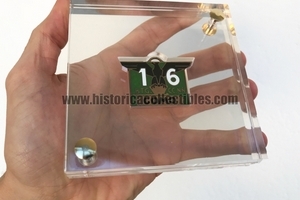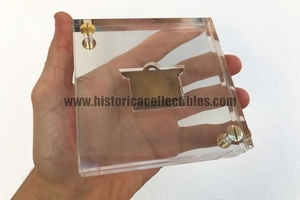Badge of the 16th Battalion CC.NN. "COMO", Lorioli brothers Milan, 1941
Badge in gilded metal and polychrome enamel, it was created by the Lorioli company of Milan in 1941 following an order received from the Manipolo Chief Mario Noseda on the letterhead of the Galbiati Group.
The order included the creation of 300 pendant pieces and 500 badge pieces to be distributed to the Black Shirts of the 16th CC.NN Battalion. "Como" under the Group, as desired by the Commander.
On 5 April 1941, Senior Ferdinando Vanini, commander of the Battalion, sent the money to Lorioli with the recommendation to make the delivery as soon as possible.
At the beginning of May the badges were ready but Lorioli did not know how to deliver them because shipments to Albania were suspended. After some time, on the indication of Chief Manipolo Noseda, they were delivered to the battalion headquarters in Como.
The badge and the pendant have the same rectangular shape in enamelled and gilded metal with the difference that the badge is equipped with a safety pin on the reverse while the pendant has a link in the center of the upper part which had to house a counter link with a lanyard in skin.
The pendant could in fact be worn attached to the button in the upper left pocket of the jacket. The badge has a late Art Deco style design with a stylized black eagle whose wings protrude from the upper edge and rests on an inverted truncated cone which in turn rests on a base bearing the wording "COMO".
On the sides of the truncated cone "BTG:" and "CC:NN:". On the sides of the eagle are the two digits that make up the number "16" in white enamel.
At the outbreak of the war in the Greek Campaign, Galbiati had been sent as a general liaison officer with the 11th Army, but his warrior temperament could not bear to sit still without being able to contribute in combat, so he asked H.E. Mussolini to assume direct command of CC.NN departments.
He was immediately satisfied; with all possible means, including destroyers and submarines, three CC.NN. assault battalions were sent to Albania, among the best available: on 23 December 1940 they had completed the landing in Vlora.
The battalions were: the VIII Battalion CC.NN. Varese - C.te 1st Senior Leopoldo Gagliardi, the XVI Battalion CC.NN. Como - C.te Sen. Ferdinando Vanini and the XXIX Battalion CC.NN. Arona - C.te 1st Sen. Ferruccio Bonapace (MOVM to Memory). The Galbiati Group was officially established in Vlora on 24 December 1940.
This grouping covered itself in glory in the famous Battle of February 13th unleashed by the Greek "Crete" division against the Italian deployment near the town of Marizai. General Galbiati assumed, by superior order, command of all the national units deployed on that front.
The tenacious and cold-armed resistance of a few battalions of Blackshirts and infantry against an entire Greek division lasted uninterrupted until the 23rd and prevented the Greeks from breaking through our lines. From the following 16th to 23rd April the group once again distinguished itself in the occupation of Valle Drino, alongside the 26th Legion of the Legnano Division which supported the Battalion. CC.NN. VII and LIII.
As for others, the value demonstrated in Albania by the 16th Battalion CC.NN. "Como" earned it the transformation into Battalion M.
In November 1941 the unit was in Croatia in Karlovac and Ogulin under the control of the Celere then of Lombardy. He was in Rome on 25 July, but did not attempt any forceful action.
It was reconstituted for a short time under the RSI in the I legione M. Enzo Emilio Galbiati was one of the leading figures of the fascist regime. Born in Monza on May 23, 1937, he fought in the First World War on the Carso and Piave. He left the army in 1920 and, having become a fascist, organized the action squads in the Monza area.
He was in command of the MVSN legions of Monza, Rieti, Perugia, Varese and Turin, becoming commander of the Legions Group of Rome in 1933.
From 1935 to 1936 he fought in the Ethiopian campaign in the Tiber division, suffering the mutilation of an arm and earning two medals for military valor. In the period preceding the Second World War he was a lieutenant general of the MVSN. In December 1940 he was sent as general liaison officer for the Black Shirts to the command of the 11th Army in Albania where, having organized a group of Black Shirts, he fought in Marizai and Val Drino, earning a decoration.
On 25 May 1941 he was appointed Chief of Staff of the Militia and remained so until 25 July 1943. He participated in the meeting of the Grand Council of fascism on 25 July and voted against Grandi's agenda. Galbiati subsequently made a brief testimonial appearance at the Verona trial against some of the signatories of the Grandi agenda without subsequently appearing in the news of the Social Republic.
Having emerged unscathed from the events of the conflict and those of the immediate post-war period, he retired to the Ligurian Riviera, to Bordighera, where he led a very reserved life until his death, which occurred in Solbiate, in the province of Como, on 23 May 1982 .






